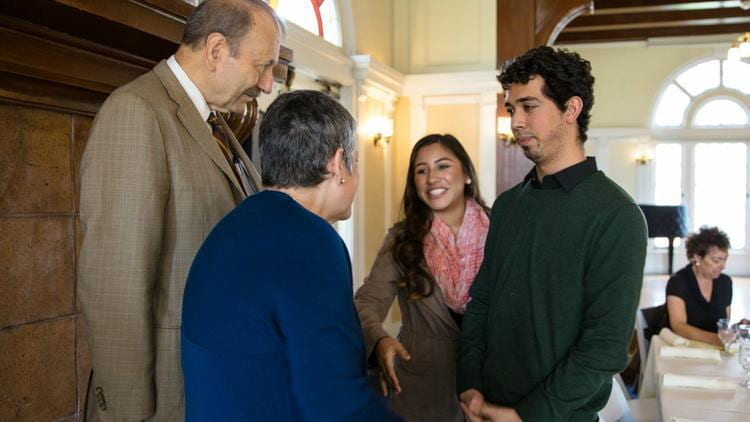So why can’t it draw more transfer students?
By Teresa Watanabe, LA Times, January 3, 2018

UC Santa Cruz Chancellor George Blumenthal, left, and University of California President Janet Napolitano, front center, meet with students at Cabrillo College in Aptos, Calif. Photo by Carolyn Lagattuta
UC Santa Cruz sits on an idyllic expanse of redwood groves and rolling meadows. World-class surf is just minutes away.
Its researchers were the first to arrange the DNA sequence of the human genome and make it publicly available.
It is quirky and colorful, with campus traditions that include a naked run through the season’s first heavy rain and a banana slug for a mascot.
So why can’t the university attract as many transfer students as the state says it must?
About nine miles away, Cabrillo College in Aptos is the closest community college. But at a recent UC Santa Cruz sales pitch featuring University of California President Janet Napolitano, numerous Cabrillo students made it clear Santa Cruz wasn’t their first transfer choice. Cal State is cheaper and classes are smaller, said one student. Santa Cruz housing is too expensive, said another. Several named UCLA or UC Berkeley as their dream schools.
“Santa Cruz life is too hippie for me.” said Rachel Biddleman, a 21-year-old studying political science. “I’m more of a city person.”
UC Santa Cruz recently launched a million-dollar effort to reach out to community college students around the state in an effort to change minds and boost its transfer numbers. The university is under pressure to meet state demands that eight of the nine UC undergraduate campuses enroll one transfer student for every two freshmen. Santa Cruz and Riverside both fall short, a failure Gov. Jerry Brown cited last year as one reason why he is withholding $50 million from UC’s budget.
Last year, Santa Cruz enrolled about three freshmen for every transfer student. Of the campuses under state scrutiny, only Riverside did worse, with about four freshmen per transfer.
State finance officials will decide this spring if the campuses have made sufficient “good faith efforts” toward meeting the ratio, which was set by Brown and Napolitano in 2015, said H.D. Palmer, the spokesman for the state finance department. He said one reason why Brown is pushing for increases is that they provide a more cost-efficient path to a four-year degree because transfer students complete their first two years of studies at the less expensive community colleges.
UC Santa Cruz Chancellor George Blumenthal, however, considers finance bureaucrats judging university enrollment actions “unbelievable micromanagement.”
But he says the campus is trying hard — starting with correcting what he said were misperceptions. People still hear the name and picture the campus “Rolling Stone” once dubbed “the stonedest place on earth.”
“Some people still think of us as a kooky place … as banana slugs, hippies and protests,” he said. “We’re also a serious university.”
At Cabrillo College, Blumenthal talked up the work on the human genome project, as well as research in marine science and astronomy and astrophysics. Students got the chance to meet a Santa Cruz faculty member whose team won worldwide acclaim this fall for becoming the first to capture the light generated by a cataclysmic merger of two neutron stars. Last fall, the London-based Times Higher Education ranked UC Santa Cruz third in the world in research influence based on how many times scholars cited its work.
Blumenthal told students from four area community colleges about the university’s undergraduate research opportunities, emphasis on social justice and leadership in environmental sustainability. He said a new summer academy could help them make the transition.
Napolitano pitched UC’s generous financial aid, diversity and support for immigrants. “The doors to the University of California are open. … Right next door is UC Santa Cruz!” she said.
The campus’ geography, however, is a barrier. A recent UC survey found that nine of 10 transfer students said they were more likely to choose a campus close to home. But many students who live in the densely populated Silicon Valley see Santa Cruz as “worlds apart” because the 30-mile trip there includes mountains and winding Highway 17, said Elizabeth Gonzalez, who works at UC Santa Cruz on support and programs for transfer and re-entry students.
Latinos, who make up four of every 10 of the state’s community college students, often are needed at home to help parents babysit, translate and earn money, Gonzalez said. So that sense of distance is a problem.
To win over parents, Gonzalez helped launch a “Family Day” last year that will bus in Latino families from San Jose each year for tours and workshops — with Spanish translation provided — on financial aid, admission requirements, academic policies, immigrant student support and special transfer programs.
UC Santa Cruz uses $10 million in federal grants to support Latino students in math and writing, undergraduate research and STEM majors. Gonzalez teaches a UC class on Latino studies at San Jose City College to try to make connections and show students they can handle UC work.
“Some students think they’re not UC material,” she said. “It’s a big misperception.”
Read more.